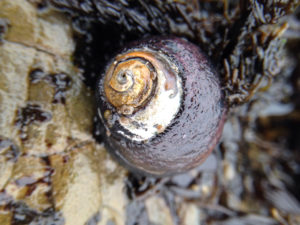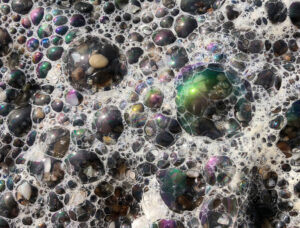Would you like to go see neat things in the miniature universe of the tidepool? Here’s a guide for getting started:
Find a low tide during the daylight. On the Northern California coast there are two low tides per day, one of which is lower than the other, and both of which vary from day to day. They’re measured in feet relative to the average water level; in most places you’ll want a low tide that’s less than 1 foot (and lower than that is better). A good one will look something like this: a -1.2 ft. “minus” tide at 7 a.m.:

Pick a place to go. Here’s a list of great tidepool areas we made a while ago that covers much of Northern California.
Proceeding, obviously, with caution about things like slippery rocks and rogue waves, make your way out to the rocks. (If you arrive right at low tide, it’s nice to go out and work your way back toward shore as the tide rises.)
Find a pool that looks good, and look close. Give it a minute or two. You’ll see the obvious stuff first — hermit crabs moving around. Seaweed and coralline algae. (But what kinds?) Larger anemones — usually aggregating anemones (Anthopleura elegantissima; the ones that live all bunched together) or starburst anemones (Anthopleura sola; the ones with stripes in the middle) or giant green anemones (Anthopleura xanthogrammica; the, uh, big green ones with no stripes). Snails — many, many beautiful snails, whelks, and periwinkles.
Watch for a few minutes more and you might notice the smaller stuff. Brilliantly colored nudibranchs like the creamsicle-orange white-spotted sea goddess or flamingo-pink Hopkins’ rose often hang out around the edges of the tidepool, or under algae. (Gently brush algae aside to see what’s underneath it.) Look in crevices for urchins, top snails, and true crabs. Scan the bottom for the wild translucent red arms of the smaller moonglow anemones (Anthopleura artemisia) or the flashlight-like burrowing anemones. Look on exposed outer rocks or around mussel beds for sea stars, particularly the characteristic raised-white-dot pattern of the keystone predator Pisaster ochraceus.

Try and name what you find. Name as many things as you can. See how many different species you can find. If you get stuck, take a picture (even a cheap iPhone macro lens will revolutionize the way you see and photograph nature), and upload it to the California Academy of Science’s mobile app iNaturalist, where there’s a great community of tidepool enthusiasts who can help you identify most anything you’ll find in a Northern California tidepool. Don’t be afraid to make mistakes; the people who do the IDs are awesome and don’t judge.
Go home and learn more. The tidepool has inspired some great writing — Ricketts’s Between Pacific Tides or Steinbeck and Rickett’s Log from the Sea of Cortez, for example — and photography. Follow Jackie Sones’s Natural History of Bodega Head for cool stories and great photos from the North Coast, or follow Alison Young on Twitter for the best finds from the California Academy of Sciences roving citizen science team.
Return to the tidepools and look again! You never know what’s out there — an intertidal survey at Pillar Point has turned up more than 550 species on that reef alone — and even experienced tidepoolers find something different every time.





